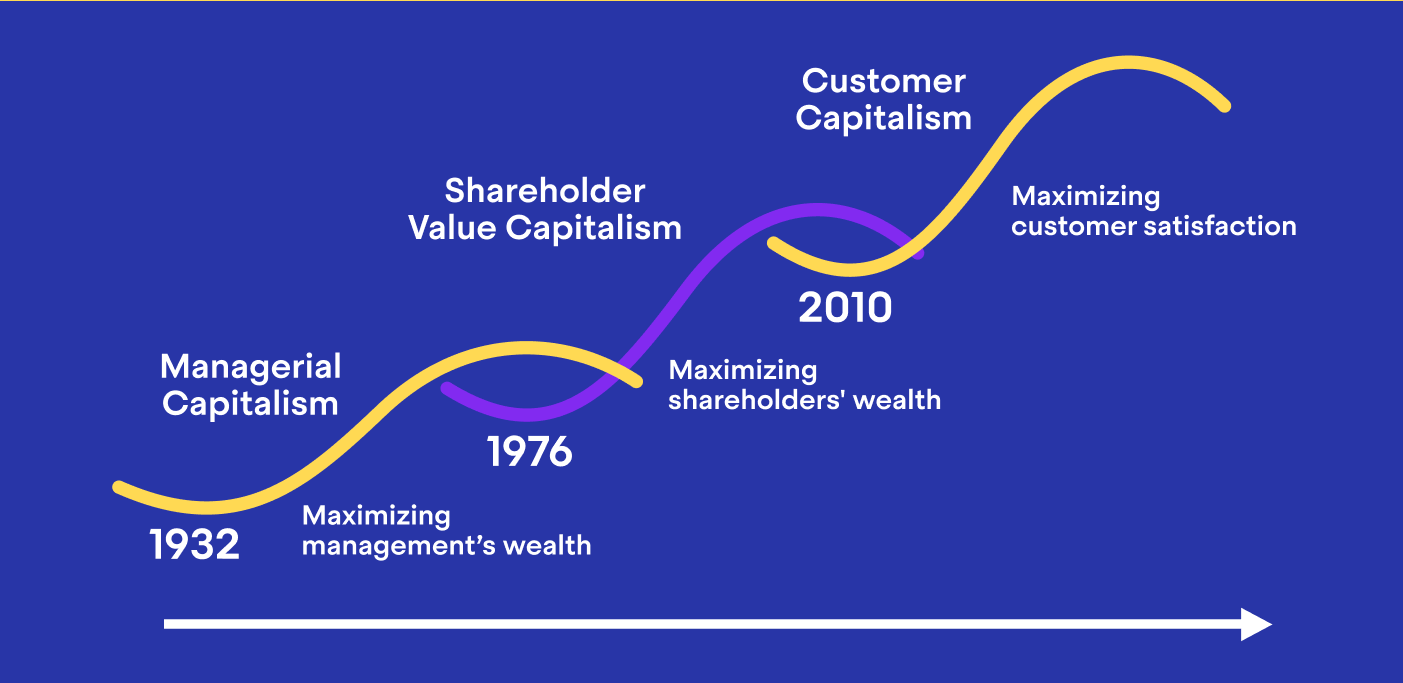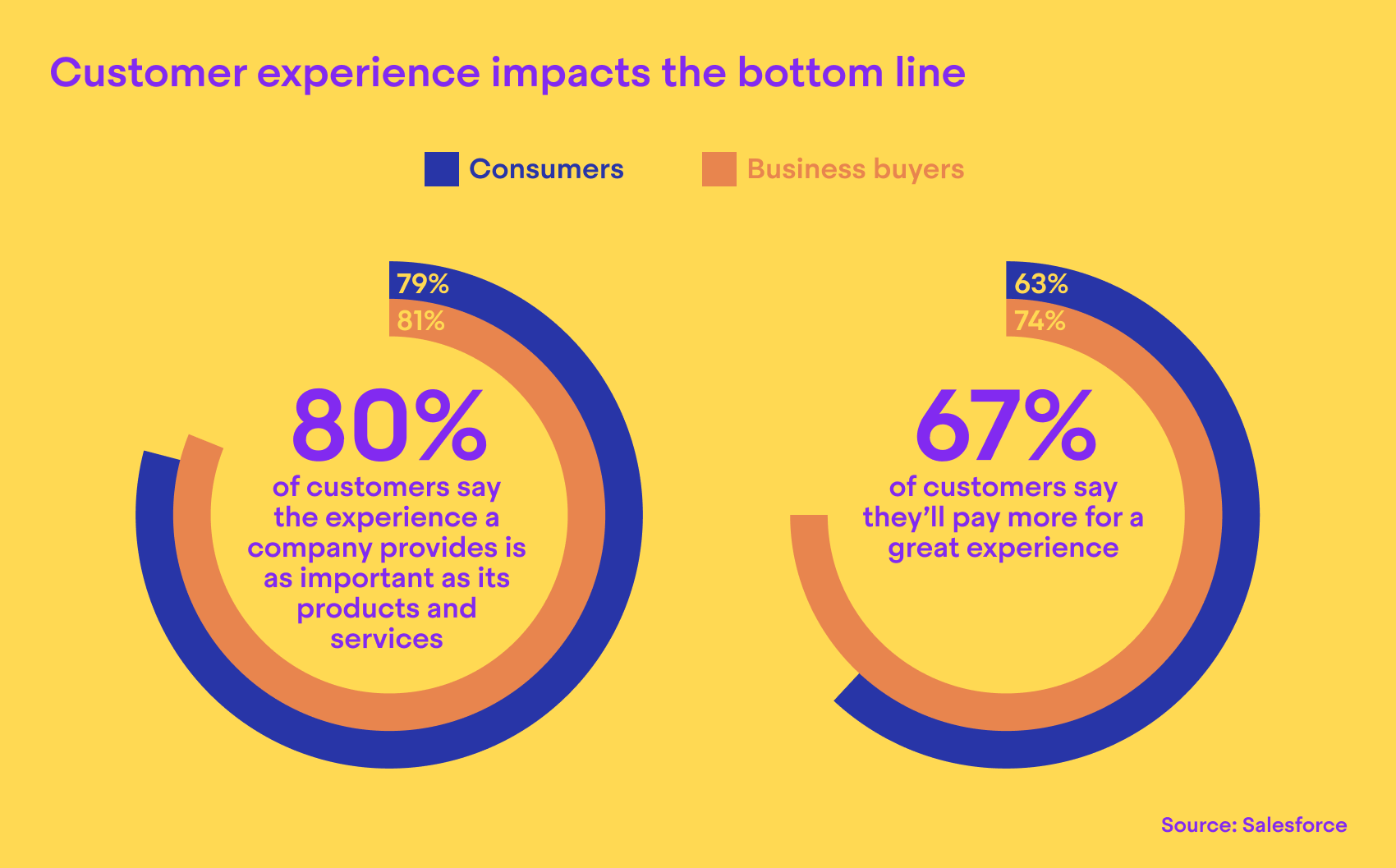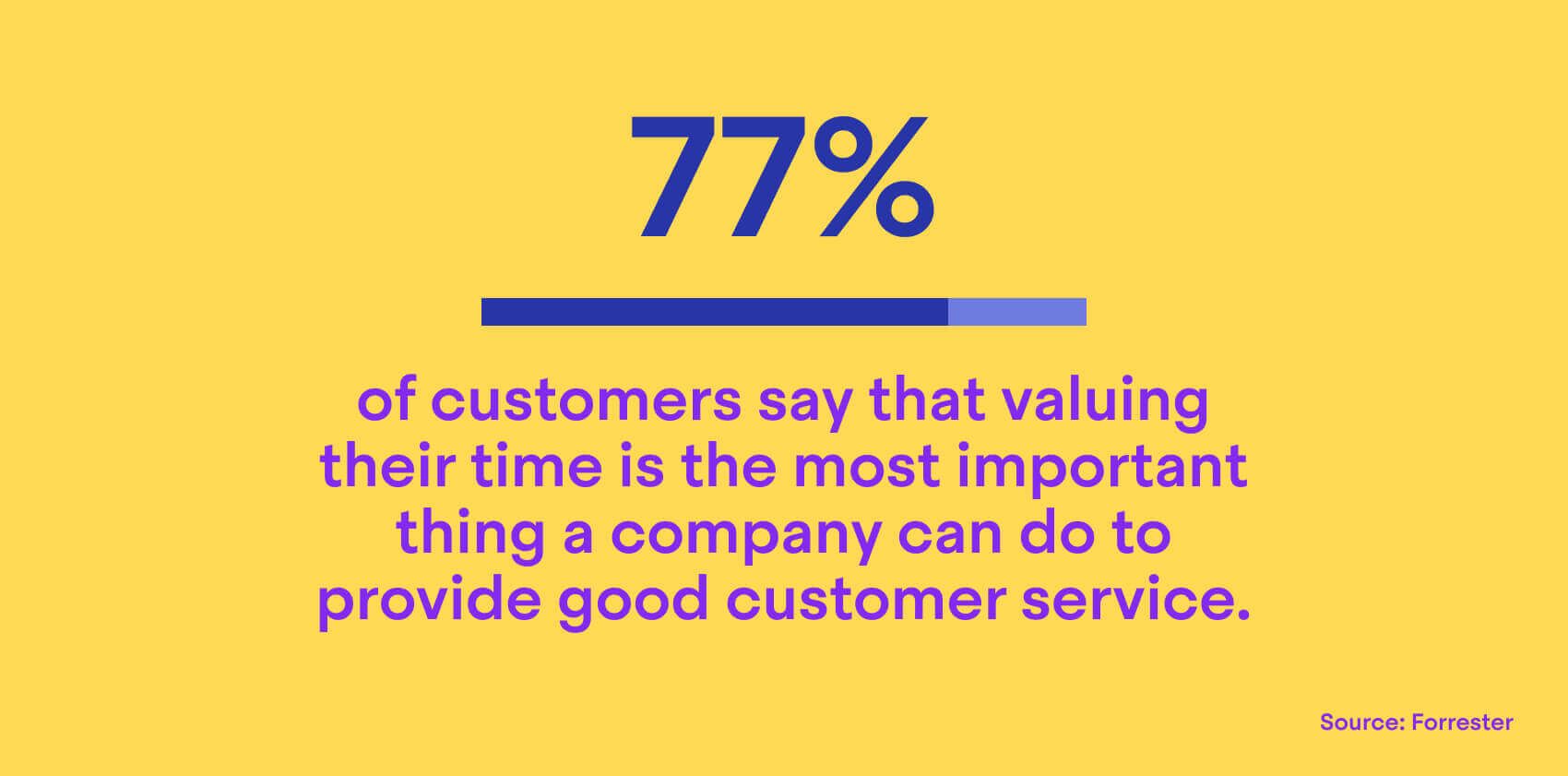
The key to fierce customer loyalty? Your support team.
Main illustration: Jason Yim
For nearly a century, companies held to the same principles for driving growth: deliver value to stakeholders and employees first, then to customers.
Over the last 10 years, this thinking has come undone. Crowded markets mean companies can no longer assume they are the only, or best, choice. The rise of the subscription model challenges businesses to place equal emphasis on conversion and retention, or risk spending themselves into oblivion. Customers, too, expect more and will put their money where their values are.
At the forefront of this move, from what businesses want to what customers need, are support teams. Support teams turn company promises to their customers into experiences that drive long-term loyalty. As consumers we know this all too well – our relationships with brands are built through our many interactions, oftentimes mundane, with frontline employees.
“Support teams turn company promises to their customers into experiences that drive long-term loyalty”
Customer loyalty is more than just a feeling of trust and emotional connection. It’s what motivates customers to continue spending time and money (67% more than new customers, to be exact) with your business. It’s a safeguard from competitors that drives sustainable growth.
We spoke to support leaders at fast-growing companies like Zapier, Wistia, Curalate, Automattic, and Algolia to learn how their teams are putting a focus on customers into practice. They share their proven strategies for increasing customer loyalty and, ultimately, the business’s bottom line.
But first, let’s take a look at how loyalty emerged as a priority, and why leading businesses are investing in customers, not stakeholders or employees, to drive up revenue.
The era of customer capitalism
In 2010, leading management thinker Roger Martin declared we’re entering the age of “customer capitalism.” It was both a reflection on the times and call-to-action for companies to drive growth through a new pecking order, one that puts customers at the top.
Customer capitalism distinguishes itself from the previous two eras of capitalism – managerial and shareholder-value – by its focus on satisfying customers above maximizing financial returns for investors or employees. As Martin explains:
“I firmly believe that if more companies made customers the top priority, the quality of corporate decision making would improve because thinking about the customer forces you to focus on improving your operations and the products and services you provide, rather than on spinning lines to shareholders.”

Let’s be clear: the notion that companies should put customers first is nothing new. Management scholar Peter Drucker, of many well-known business adages, wrote in his 1954 book The Practice of Management, “There is only one valid purpose of a corporation, to create a customer.”
What is new is the widespread commitment to fulfilling this purpose. Companies like Apple, Netflix, and Slack have proven the profitability of a customer-centric ethos. Take Slack – this one-time gaming startup has grown from a new way of working into the way of working and is now worth over $20 billion. Behind their growth? A “radical convenience” approach to customer experience that’s all about anticipating people’s needs.
“Companies like Apple, Netflix, and Slack have proven the profitability of a customer-centric ethos”
Ten years after Martin’s declaration, customer capitalism finally, and truly, triumphed. Public feedback channels like social media and crowd-sourced reviews, just one example of customers’ power, are keeping companies honest. In this world, 10-hour customer service calls – thank you, Zappos – are not just a sign of customer care but, frankly, good for business.
So, if putting your customers first is the key to growth, then how can companies actually do it?
Offer a great product – and great support
There’s a common trap that companies fall into over and over again. It’s the belief that if you build a great product or offer an outstanding service, the rest will fall into place.
Support leaders know this isn’t true. The reality is customers aren’t sticking around just for your product or service; they’re here for the experience. Salesforce found 80% of customers say the experience a company provides is as important as its products and services. And customers will pull out their wallets for it, too: 67% say they’ll pay more for a great experience.

As Philip Miller, the Head of Customer Experience at social commerce platform Curalate, told us, both the quality of the product and the support experience directly impact customer loyalty:
 |
“If the company isn’t getting the overall value from the product, clients won’t renew simply on support alone. That said, if a vendor has historically negative client support experiences, it absolutely factors into retention in a significant way.” |
Delivering a great support experience isn’t as straightforward as answering a customer’s question and calling it a day. Teams must also be able to identify why these issues are happening in the product and resolve them – for good.
At Zapier, the support team keeps a close eye on their customers’ success, long after the ticket is closed. Here’s their VP of Customer Support & Success Pam Dodrill on how she’s tracking her team’s impact on the business:
 |
“We’re building datasets that will show us the success of our customers if they contact support. Do we retain them? Do they grow their usage? Is that particular part of the product working 30 days after we help them?” |
A great product is necessary to fostering loyal customers – don’t get us wrong – but it’s not everything. Customers want, and expect, a support experience that’s just as good.
Reduce friction, increase satisfaction
We’ve all had bad support experiences. You know, the kind that feels like you’re participating in the “hello-can-anyone-help-me” Olympics. This is one gold medal we’ll gladly forfeit.
It’s no surprise that the biggest driver of disloyalty in customer support interactions is friction. The more effort customers have to put in, the more likely they are to take their business elsewhere. In fact, 96% of customers who have high-effort experiences report being disloyal, compared to only 9% of customers with low-effort experiences.

Sean Kinney, the Head of Support at search platform Algolia, says he thinks about reducing friction in terms of speed. Customers want their problems solved with fast and few responses.
 |
“Customers want their issues solved with as little friction as possible. That means you want to minimize the number of responses you’re sending before resolution, and you want those responses to be brief but thorough. You also want to minimize the time-to-first-reply and the time-to-resolution as much as possible.” |
If speed is one factor in meeting customer expectations, another is completeness. That is, how effective is your support team in fully resolving your customers’ problem? In the Support Olympics, customers aren’t looking to come back for another full day of events.
At video hosting platform Wistia, their support team measures completeness as part of their internal quality score. Their Director of Customer Happiness Stacy Justino explains how “completeness” impacts not just quality but speed of resolution as well:
 |
“There is a correlation between level of effort (perceived and actual) and customer loyalty. We’ve incorporated elements such as completeness into our quality criteria to focus on minimizing customer effort. [Cutting] down on unnecessary back and forth positively impacts both quality and speed of resolution, as highlighted by recent customer feedback: ‘My questions were answered quickly and clearly and so I was able to get my issue resolved right away’” |
By reducing friction – resolving problems quickly, not asking customers to repeat themselves, and minimizing the chances that customers need to contact support again – there’s a big opportunity to create customer loyalty instead of headaches.
Help customers help themselves
Having to contact human support, no matter how high quality the interaction, can never reduce a customer’s friction to zero. Just think about it: in order to talk to someone about your issue, you have to step away from other work. It’s time-consuming, even when it’s fast.
The majority of customers – 81% according to a recent study – will attempt to solve problems on their own first. Why? Because what customers actually value most is their time. That’s reflected in their definition of good service: 77% say valuing their time is the most important thing a company can do.

That’s exactly how the team at Automattic, the company behind WordPress, Tumblr, and more, approach customer support. Andrea Bishop, the Support Lead for WordPress VIP, says their goal is to enable customers to find solutions without ever needing to reach out to support:
 |
“When someone has to take the time to ask questions, I approach it from the standpoint that our product, documentation, and onboarding need improvement. After we fix the issue in the ticket, we fix it again in one of those other areas to enable future customers to reach solutions on their own.” |
One of the best, and most cost-effective, ways to provide customer self-service is automation. Tools like chatbots, once painfully poor substitutes for real humans (Remember Jenn? 😬), now provide immediate and complete resolutions to customer issues.
At Intercom, we’ve doubled down on automation because it works for our customers. Our Head of Support Operations Ryan Steinberg explains how automation gets customers to their desired outcomes, while respecting their time:
 |
“Automation is a super personal way to provide support because it means you’re thinking about the time your customers have to spend getting answers to the questions they have about your product. If support automation can step in and answer somebody’s question in 30 seconds – 10 times faster than any human possibly could – you respected their time as an individual. They got their question answered, moved on with their day, and continued to use your product in a more effective manner.” |
If customers know they can resolve their issues immediately, without jumping through hoops, they’re much more likely to stick around and grow with your business.
Customer loyalty comes from customer care
The work that modern support teams put in demonstrates just how genuinely they care and customers are picking up on that. By investing time and effort in delivering a high-quality support experience, reducing friction and effort, and respecting customers’ time, support teams are showing their customers that they, not stakeholders or employees, come first. And, in return, these businesses are being rewarded with fierce loyalty – and faster growth.
This post is part of Scale, a place where we explore how businesses are driving growth through customer relationships. Scale offers advice and guidance from support, marketing, and sales leaders who are charting new paths for their customers – and their companies.







